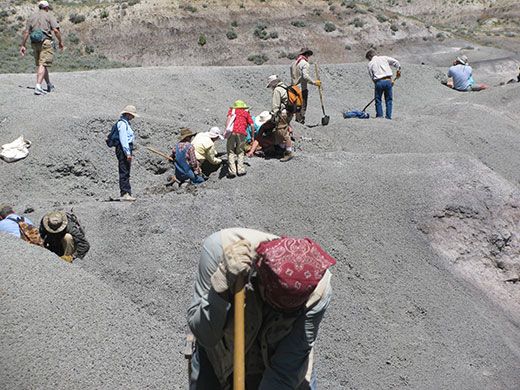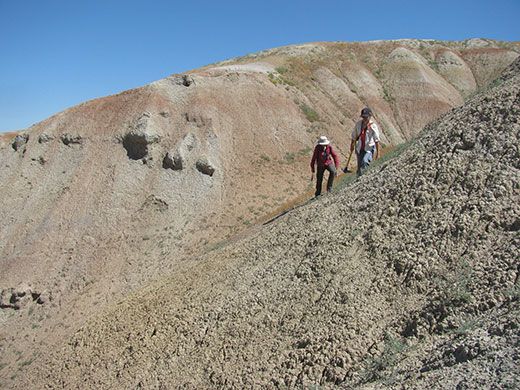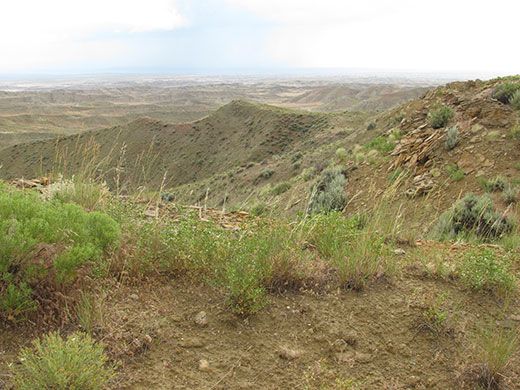Wyoming Paleontology Dispatch #5: An All-Star Team of Scientists
A geologist, a geochemist and a paleontologist go into an (ancient sand) bar
/https://tf-cmsv2-smithsonianmag-media.s3.amazonaws.com/filer/Wyoming-dinosaur-dispatch-5-researchers-631.jpg)
The days after the barbecue at the Churchills’ have flown by. Our party now consists of six: volunteer Pam Hamilton, University of Florida grad student Sarah Wilson, Penn State grad student Elizabeth Denis, University of Wyoming grad student Brady Foreman and Northwestern University grad student Allie Baczynski.
Sarah’s expertise is closest to my own in that she works on plant fossils, but she has a special interest in plant reproductive parts—fossilized flowers and fruits—because they contain a great deal of information that helps determine how the fossil plants are related to living ones. The catch is that fossil flowers and fruits are rare compared with leaves. We have found quite a few fruits, though, at one site, and even a couple of specimens of a type of flower with many pointed sepals, or petals, that I have nicknamed “Sarah’s spiky flower.”
Brady is a geologist who studies ancient river systems, so his eyes are tuned to the sandstones that represent the ancient channels. He can look at a steep face of sandstone and see in it the fossilized ripples that the current deposited on the bed of the river. That can tell him which way the river flowed, and the dimensions of the sandstone body holds clues about the size of the stream. He wants to understand how Paleocene-Eocene Thermal Maximum (PETM) climate changes affected the river systems in the Bighorn Basin.
Allie and Elizabeth are geochemists, and their projects involve extracting organic compounds from the rocks we are collecting. They will treat the rocks with various solvents to remove and concentrate molecules that are ultimately derived from plants that lived during the PETM. Like me they are interested in how plants and the environment changed during this major climatic shift, but our approaches are very different. Plant fossils of the sort Sarah and I study can be identified quite precisely, which makes it possible for us to document what species were present. We use the climatic preferences of their living relatives to reach conclusions about the climate of the PETM. We can also use the sizes and shapes of the fossil leaves to infer what the climate was like.
The chemical approach yields more general information about what kinds of plants were present, perhaps allowing conifers to be distinguished from broad-leaved plants, for example. But the organic compounds also reveal things we don’t usually know from the more obvious fossils: the effects of drought stress, the frequency of wildfires, and even the ratio of the two stable isotopes of carbon in the PETM atmosphere. The organic compounds are also preserved more easily than larger plant fossils, so they are found in more layers of rock, allowing changes to be reconstructed at more closely spaced time intervals. Although I love the information that these newer chemical approaches provide, the geochemists don’t know until they return to the lab if they have found something special. I am pleased that I can still thrill to a lucky hammer stroke that reveals a lovely and informative fossil leaf.
As in any field season, we’ve had a series of distractions and small annoyances. Dino’s water pump blew on July 7. We limped in to Worland, fortunately, where the ever-resourceful Stan Wostenberg pulled a vintage 1970s water pump from his collection and put Dino right again. I have come to expect approximately one mechanical problem per field season with my antique field vehicle, and have gotten to the point where I’m just glad when it doesn’t involve hours of walking out of the badlands.
On July 9, we spent most of the day showing a group organized by the Wyoming Native Plant Society, the Bureau of Land Management, the Buffalo Bill Historical Center and the Washakie Museum around a Cretaceous fossil plant site at a place called Big Cedar Ridge. It was a delightful excursion with a group of really sharp and inquisitive folks, but it also ate up another day when we could have been collecting PETM fossils. The field season is always too short!
The next day, as we followed a two-track out of camp to one of my PETM plant sites, Dino gave a slight lurch to the left and I heard a rhythmic slapping sound from the rear tire—first flat of the year. It was only a matter of 15 minutes before we had the spare on, but getting the flat fixed meant another run into town the next day. By the end of the day on July 11, I had to bring a halt to normal field operations because of the impending coring program. Sarah and Pam leave the next day, and Brady, Elizabeth, Allie and I join others in the Bighorn Basin Coring Project to begin the project at a site west of Basin, Wyoming.
Scott Wing is a research scientist and curator in the Smithsonian Institution’s Department of Paleobiology.
/https://tf-cmsv2-smithsonianmag-media.s3.amazonaws.com/accounts/headshot/SLW_photo_-James_Kegley_for_Smithsonian.jpg)



/https://tf-cmsv2-smithsonianmag-media.s3.amazonaws.com/accounts/headshot/SLW_photo_-James_Kegley_for_Smithsonian.jpg)